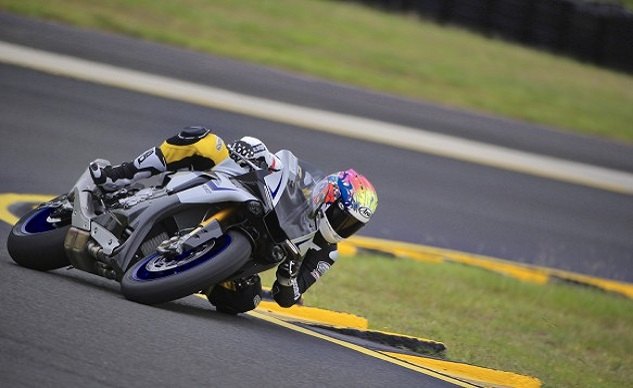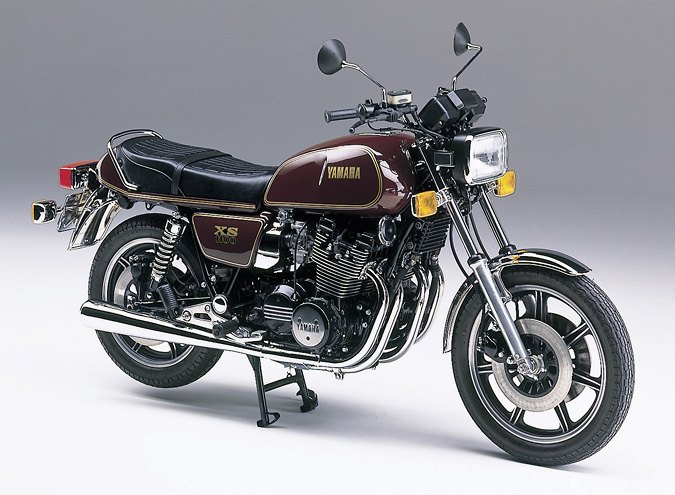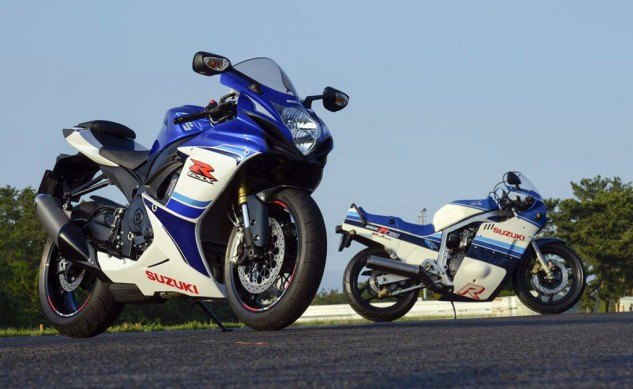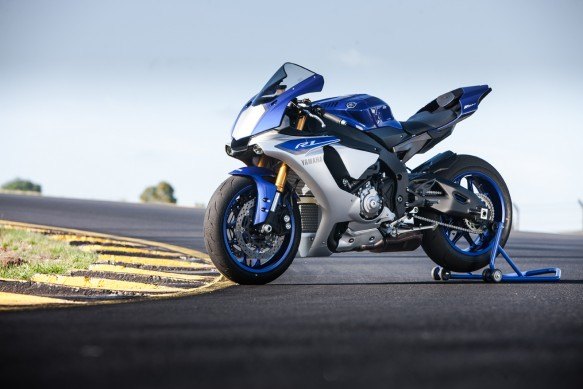
 |
|
|
#1 |
|
All the news that's fit to excerpt
Name: newsie
Location: who knows?
Join Date: Jun 2008 Motorcycle(s): only digital replicas Posts: Too much.
|
[motorcycle.com] - Head Shake The Age of Flight
 We live in an age of specialization and performance. A few words written by one of MO’s finest the other day drove this home to me. He had muttered those magic words: “200 miles per hour.” That is a very impressive number indeed. There was a time when topping a “Ton” (100 mph) was the magic number to the porridge pot helmet crowd on their British cafe racers, today we can kick around the notion of 200 mph without being regarded as completely daft.* How did we get here? I started riding on the street in the dual shock era, when frames were made out of baked ziti and the suspensions were cranked to extra-firm with what minor adjustments we could make. Today the frames are as stiff as is called for and the suspensions are compliant using their full range of motion, or even active with brains of their own. In the beginning, or my beginning, there were UJMs, or Universal Japanese Motorcycles. Even the Gold Wing, when introduced, came sans fairing. If you wanted a touring bike you bought a Windjammer, a set of JC Whitney saddlebags and POOF! you had a touring bike. If you wanted a sport-tourer you bought a tank bag and maybe some soft bags. If you wanted a superbike you bought a UJM and a set of rear sets, K&N Superbike bars, a four into one exhaust from Kerker, or Bassani, or Ontario MotoTech. Then came cams, high compression pistons, an oil cooler, a set of shocks and fork springs, a fork brace, etc., and you built a superbike. This wasn’t lost on the manufacturers, and they wanted a piece of this action. The first tip off should have been the introduction of the factory customs. Willie G. led off that niche market having recognized what customers were doing and responded with the Super Glide, followed by the FXS Low Rider in 1977. The Japanese OEMs answered with factory cruisers of their own; Kawasaki LTDs, Suzuki’s GS-L series, and Yamaha Midnight Specials filled showrooms. It was only a matter of time until you had Eddie Lawson Replicas (the street going version) and Wes Cooley specials to appeal to what would be the knee dragging crowd.The factories had given customers what they wanted, be it a cruiser or a repli-racer, and spared them the time and expense of doing it themselves. But something different was in the works as well. Another need that the OEMs had yet to address, but I’m getting ahead of myself. Consider the short period of time where we went from old Bell Star helmets and a pair of Frye boots as proper riding gear on the street – The Leaded Gas era when dual shocks, drum brakes, and non-adjustable suspensions with the notable exception of preload were de rigueur – to an age where fly by wire technology in two wheeled form is fast becoming a reality. Just compare and contrast a 1980 Yamaha XS1100 (the Xcessive11, w/factory equipped see-saw shaft effect) to a 2015 Yamaha YZF-R1 and see how far we have come in 35 years.  Thirty five years ago this was Yamaha’s “superbike.” It could run a sub-12 second quarter mile, win a production roadrace, and you could stick a Windjammer fairing on it and go touring. You could also get a King and Queen seat if you so desired. Thirty five years ago this was Yamaha’s “superbike.” It could run a sub-12 second quarter mile, win a production roadrace, and you could stick a Windjammer fairing on it and go touring. You could also get a King and Queen seat if you so desired.It is remarkable; it is like living through the advent of the mono-wing prop plane era, the age of jets, and arriving in the fly-by-wire air superiority fighter world. And all the technology, all the components from the tires on up followed suit. We had plodded along quite happily for decades beforehand, a small innovation here and there, and then the Japanese arrived on our shores in earnest in the 1960s. They announced their arrival with friendly little bikes (You Meet the Nicest People…). They were unassuming, seemingly a non-threat to the established marques of the day. But before too long starting with Honda, the Japanese OEMs had stepped up their game. The introduction of the “big” multis – seemingly exotic and affordable for the day – made a big splash. Couple that with radically increased sales in the 60s and early 70s and suddenly you had an exponentially larger market yearning for more. Then 1983 happened and all hell broke loose.  Thirty years of SRAD, Slingshot, GSX-R no compromise race-winning hardware. If the Interceptor jumped off the deep end, the GSX-R cannonballed off the high dive. Thirty years of SRAD, Slingshot, GSX-R no compromise race-winning hardware. If the Interceptor jumped off the deep end, the GSX-R cannonballed off the high dive.The OEMs had found that other need yet to be addressed, but this would go far beyond simple visual cues or ergonomic modifications to existing standard offerings. This was about performance. The year 1983 heralded the introduction of the VF750F, aka., the Interceptor, and with that the race was on; transitioning from air-cooled to liquid-cooled, dual shock to mono shock, a frame that looked more like it belonged at the Suzuka 8 Hour or Bol d’or than in a Honda showroom, a 16-inch front wheel that would steer in quicker (and tuck faster) than anything previously. Rather than a UJM modified for sporting purposes, this was a sportbike from its inception. Many of these innovations at one time or another had been used before but never before had they been brought together to produce what to all the world looked, and acted, like a race bike with lights priced at a level that made it available to the general public. When the Interceptor was introduced in 1983 it cost exactly 100 dollars more than the Honda Sabre had only one year before. I know this because I was one of those unfortunates that had bought a new Sabre the year before and wanted to kick myself every time I saw a VF750F. The Sabre was a good bike for what it was, but Freddie Spencer was not going to race a Sabre at Daytona or anywhere else. Some of the innovations were found to be less than innovative, the 16 inch front wheels were abandoned in favor of the 17 inch eventually by all the manufacturers, and neither air forks nor anti-dive forks lived up to their promise. But the chassis continued to evolve. The other OEMs were not about to sit around without responding in some manner, which is exactly what they did. The Kawasaki ZX900 Ninja was introduced in 1984 and a new term was expropriated by the safety-ninnies to designate any faired sportbike thereafter; The Ninja-bike (implicit handwringer connotation: This thing will KILL you!). Suzuki’s GSX-R was introduced in 1985 and with it aluminum frames and an unapologetic take-me-to-the-racetrack setup that screamed: No compromise here. Yamaha FZs, and later FZRs, followed suit. Light weight and mass centralization were the order of the day. The aftermarket caught the wave too. The U.S.S.R. toppled, and with the end of the Cold War so did titanium prices. Suddenly you didn’t need to be a factory team to afford a titaniumpipe or fasteners. Fuel injection became mandatory, jetting kits gave way to Power Commanders and Bazzaz controllers. The OEMs followed suit with titanium, magnesium, and carbon fiber components where once they had used more pedestrian materials. Electronic rider aids proliferated. In all of this we ended up with bikes that accelerated harder, slowed faster, turned quicker, and were lighter and safer than ever before. This all occurred within a brief period of time starting roughly from the early 80s and through the 90s, and but for a brief pause for an inconvenient worldwide economic catastrophe, does not appear to be abating any time soon. UJMs are the exception rather than the rule today, it is the age of the specialty bike; adventure-tourers, dual-sport bikes, touring bikes, sport tourers, retro bikes, cruisers and power cruisers. Along the way we did suffer some regrettable losses, namely road-going two strokes that were chased out of the U.S. by our EPA, and some not so regrettable flash in the pans like the short lived turbo craze that came and went.  We’ve come a long way in 35 years, gone are leisure suits and King and Queen seats. The 2015 YZF-R1, Yamaha’s superbike today. We’ve come a long way in 35 years, gone are leisure suits and King and Queen seats. The 2015 YZF-R1, Yamaha’s superbike today.Concurrent with all this change, there was one constant – The enthusiast. Our gear has changed, and for the better, but what drove us to ride, and our rising expectations, that was a constant. We find ourselves today in a world where we have the most desirable performance bikes ever made, a wider variety of bikes for a wider variety of purposes than ever before, and a renewed emphasis on entry level bikes the likes of which I have not seen since the late 60s and 70s. Forget the good old days, these may be the good old days. It has never been better for riders or for a prospective new rider. And times have changed; forget the “Ton.” Think two Tons.* Ride safe, take it to the track, look where you want to go, and hold your line… (*in closed-circuit conditions, of course) Head Shake – The Age of Flight appeared first on Motorcycle.com. Click here for full story...
__________________________________________________
I'm a bot. I don't need no stinkin' signature... |
|
|

|
 |
 Similar Threads
Similar Threads
|
||||
| Thread | Thread Starter | Forum | Replies | Last Post |
| [motorcycle.com] - Head Shake – For Our Own Good? | Ninjette Newsbot | Motorcycling News | 0 | May 20th, 2015 03:30 PM |
| [motorcycle.com] - Head Shake – The Wall | Ninjette Newsbot | Motorcycling News | 0 | April 8th, 2015 12:50 PM |
| [motorcycle.com] - Head Shake – Recycling | Ninjette Newsbot | Motorcycling News | 0 | September 3rd, 2014 06:20 PM |
| [motorcycle.com] - Head-Shake – The Rules | Ninjette Newsbot | Motorcycling News | 0 | May 21st, 2014 01:10 PM |
| [motorcycle.com] - Head Shake Helping | Ninjette Newsbot | Motorcycling News | 0 | April 9th, 2014 06:00 PM |
|
|